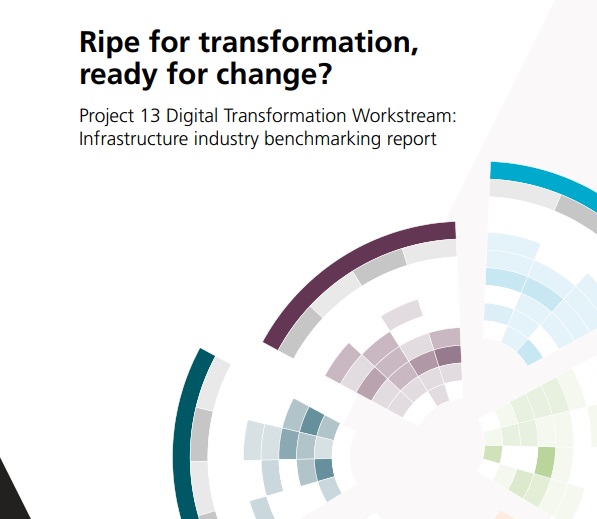Ripe for transformation, ready for change?
A new report assessing the readiness of the infrastructure industry for digital transformation was published by the Infrastructure Client Group (ICG) in July 2018.
‘Ripe for transformation, ready for change?’ provides a snapshot of the UK infrastructure industry - focusing on the infrastructure owners in energy, transport and water sectors - to help inform the development of a national digital transformation strategy.
The report was led by Mott MacDonald and the Project 13 Digital Transformation workstream – sponsored by the ICG and the Institution of Civil Engineers (ICE).
To inform the report, Mott MacDonald facilitated face-to-face workshops with digital leaders and key ‘information people’ from Infrastructure Client Group members and other leading asset owners. The owner organisations self-assessed their maturity against the Industry Readiness Level (IRL), a measure of digital maturity across six broad topics that reflect the impact of digital transformation on all parts of the business: Customers, Leadership, Commercial, Capability, Asset delivery, and Asset management.
The report found that despite a range of readiness levels, common themes were clear across all organisations which took part:
- Understand who your customers are – and what they want: Create a line of sight between the enterprise and citizens as the ultimate customers, to understand how they value infrastructure and what outcomes really matter.
- Embrace digital transformation as key to business success: With leadership from executive level, implement a coherent digital transformation strategy that supports the overall corporate strategy.
- Break down data silos and better understand whole-life performance: Start treating information as an asset; focus on making better use of information, creating the platform to unlock more whole-life value from existing assets.
- Keep aspirations high – but get the basics right first: Focus on embedding basic good practice (e.g. BIM level 2) as business-as-usual across the whole enterprise. Get data quality right as a key foundation.
- Make information security everyone’s responsibility, not just those in corporate IT: Develop a culture of personal responsibility for information security similar to that for health and safety – both internally and for partners.
The report will be used by the Digital Transformation workstream to inform the consistent development of digital transformation strategies across the Infrastructure Client Group members and the wider industry.
Mark Enzer, Digital Transformation workstream lead and Chief Technical Officer at Mott MacDonald, said:
“We are really pleased to deliver this benchmark of the industry’s current readiness for digital transformation. What this exercise has highlighted is that action is required by all owners, and their supply chain partners, to capitalise on this exciting opportunity to move our industry into the future.
“We need to recognise infrastructure as an information-based industry, in which better decisions, based on better data, lead to better outcomes for the ultimate customers – our citizens. We need to start treating information as an asset, managing and valuing it accordingly. We also need to put coherent digital transformation strategies in place that will release the value of information in the delivery, operation, maintenance and use of infrastructure.”
This article was originally published here by ICE on Designing Buildings Wiki. It was written by Emma Beer.
--The Institution of Civil Engineers
[edit] Related articles on Designing Buildings
- Articles by ICE on Designing Buildings Wiki.
- Digital transformation - engineers need to keep pace.
- How to make the digital revolution a success.
- Project 13 and World Economic Forum partnership.
- Project 13 programme.
- State of the nation: Digital transformation.
- The impact of digital on civil engineering.
Featured articles and news
RTPI leader to become new CIOB Chief Executive Officer
Dr Victoria Hills MRTPI, FICE to take over after Caroline Gumble’s departure.
Social and affordable housing, a long term plan for delivery
The “Delivering a Decade of Renewal for Social and Affordable Housing” strategy sets out future path.
A change to adoptive architecture
Effects of global weather warming on architectural detailing, material choice and human interaction.
The proposed publicly owned and backed subsidiary of Homes England, to facilitate new homes.
How big is the problem and what can we do to mitigate the effects?
Overheating guidance and tools for building designers
A number of cool guides to help with the heat.
The UK's Modern Industrial Strategy: A 10 year plan
Previous consultation criticism, current key elements and general support with some persisting reservations.
Building Safety Regulator reforms
New roles, new staff and a new fast track service pave the way for a single construction regulator.
Architectural Technologist CPDs and Communications
CIAT CPD… and how you can do it!
Cooling centres and cool spaces
Managing extreme heat in cities by directing the public to places for heat stress relief and water sources.
Winter gardens: A brief history and warm variations
Extending the season with glass in different forms and terms.
Restoring Great Yarmouth's Winter Gardens
Transforming one of the least sustainable constructions imaginable.
Construction Skills Mission Board launch sector drive
Newly formed government and industry collaboration set strategy for recruiting an additional 100,000 construction workers a year.
New Architects Code comes into effect in September 2025
ARB Architects Code of Conduct and Practice available with ongoing consultation regarding guidance.
Welsh Skills Body (Medr) launches ambitious plan
The new skills body brings together funding and regulation of tertiary education and research for the devolved nation.
Paul Gandy FCIOB announced as next CIOB President
Former Tilbury Douglas CEO takes helm.
UK Infrastructure: A 10 Year Strategy. In brief with reactions
With the National Infrastructure and Service Transformation Authority (NISTA).
























